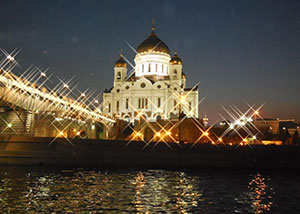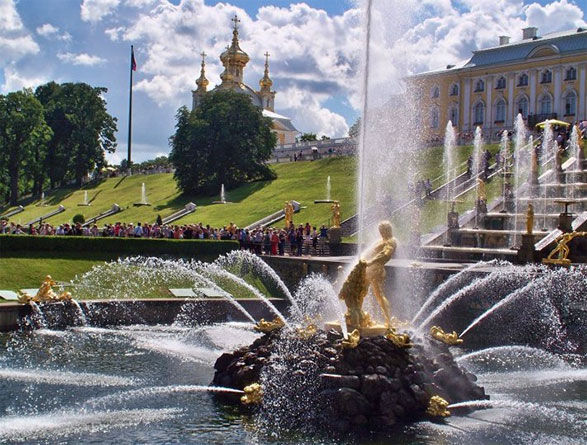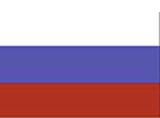
|



By 988, Oleg's great-grandson Vladimir I was ruler of a kingdom that extended as far as the Black Sea, the Caucasus Mountains and the Volga River. Wanting to establish a state religion, Vladimir decided upon Greek Orthodoxy. Vladimir was succeeded by Yaroslav the Wise, whose reign marked the summit of the Kievan Rus kingdom.
In 1240 Kiev was destroyed by the Mongol Empire, and Russia was put under the suzerainty of the Khanate of the Golden Horde. The next two centuries saw the rise of Moscow as a provincial capital and the center of the Orthodox Church.
In the late fifteenth century, Ivan III threw off the Mongol oppression. His son, Ivan the Terrible (1533-84), is considered the first Muscovite tsar and the one who founded the Russian state. Russia gained much more territory, established a strong army, and modernized the economy during this time. The Rurik Dynasty gave way to the Romanov Dynasty. Russia remained largely medieval until the reign of Peter the Great (1689-1725). Peter made extensive reforms aimed at westernization and extended Russia’s boundaries to the west.
During the reign of Alexander I (1801-1825), Napoleon’s attempt to invade Russia in 1812 was unsuccessful, and new territory was gained, including Finland (1809) and Bessarabia (1812). Alexander II (1855-81) pushed Russia’s borders to the Pacific and into central Asia.
World War I (1914-1918) demonstrated tsarist corruption and only patriotism held the poorly equipped army together. In 1917 the Bolshevik revolution, engineered by Vladimir Lenin, gave authority to the Council of People’s Commissars, with Lenin as the first premier of the Soviet Union. The Treaty of Brest-Litovsk (1918) concluded the war with Germany, but a brutal civil war delayed Communist control.
 The Union of Soviet Socialist Republics (USSR) was established as a federation in 1922. Following Lenin, Stalin became leader in 1929 and further consolidated his power by a series of horrific purges of leaders and people. Stalin assumed the premiership, and the Soviet Union was transformed from a nation based on agriculture to a global superpower.
The Union of Soviet Socialist Republics (USSR) was established as a federation in 1922. Following Lenin, Stalin became leader in 1929 and further consolidated his power by a series of horrific purges of leaders and people. Stalin assumed the premiership, and the Soviet Union was transformed from a nation based on agriculture to a global superpower.In 1939 the Soviet Union signed a nonaggression pact with Nazi Germany. Moscow joined in the German attack on Poland, seizing territory which was incorporated into the republics of Ukraine and Belarus. In 1940 the war with Finland added many new territories, especially Bessarabia and Bukovina, which became the new republic of Moldavia, and the republics of Estonia, Latvia and Lithuania. World War II (1941-1945) started when Germany unexpectedly invaded Russia but was eventually stopped before they reached Moscow.
Following Stalin was Nikita Khrushchev (1953 -1964). Khrushchev was responsible for the construction of the Berlin Wall in 1961. Then followed Leonid Brezhnev. The highlight of his reign was the signing of the Helsinki Act (1975), which recognized the postwar frontiers in Eastern and Central Europe, legitimizing Soviet domination over the region. During this time, the Soviet Union reached the peak of its strategic world power.
Mikhail Gorbachev (1985-1991), the next significant leader, will be remembered for his attempts at political and social reform that ended the USSR. He introduced glasnost (openness) and perestroika (restructuring), which gave the people the freedom of speech. The loosening of Soviet control over Eastern Europe effectively ended the Cold War. As the USSR disintegrated, Gorbachev was forced to resign and Yeltsin was elected as the first president of Russia in 1991. That year, Ukraine voted for independence, a move that signaled the establishment of the Commonwealth of Independent States (CIS).
The election of presidents in Russia marked the beginning of a new political era. From Yeltsin to Putin, there was a growing accountability to the people and an urge for independence from the USSR. With the end of the USSR, economic restructuring accelerated. In 1998, an economic crisis emerged when the government defaulted on its debts, causing the value of the ruble to collapse. Yeltsin resigned, and Vladimir Putin became Acting President. In 2000 Putin's election marked a new beginning in Russian's post-Soviet history. In 2008 Dmitry Medvedev was elected as the third official president of Russia. And in 2012 Vladimir Putin was again chosen to be president.
Russia is approximately two times the size of the United States. The capital is Moscow. Within Russia are 48 oblasts (provinces) and 21 republics. The official language is Russian. The Russian territory contains all the major vegetation zones of the world except a tropical rain forest.
Russia is a multi-ethnic and multi-faith nation. Orthodox Christianity is Russia's largest religion with 75% of the population belonging to the Orthodox Church. Islam is professed by 5%; and Catholicism, Protestantism, Judaism and Buddhism are each professed by 1% of the population. Due to seven decades of Soviet militant atheism, today Russia has many non-practicing “religious” people and non-believers.
Even before the fall of the Soviet Union, Slavic Missionary Service was assisting the believers in Russia with Bibles, spiritual materials and humanitarian aid. After the disbanding of the USSR, Slavic Missionary Service began assisting some regions of Russia with national missionaries. Also, as donations were received, evangelistic conferences were held, churches were built; and many new outreaches were instituted, such as Biblical seminars, youth conferences, summer camps and small group Bible studies.


Russia currently uses eleven standard time zones. (Two new time zones were introduced in 2014.) Moscow is seven hours ahead of the United States (Eastern Standard Time).

The currency is the Russian Ruble. One dollar equals 67 rubles.



